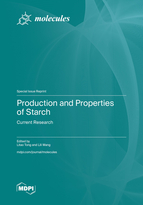Production and Properties of Starch—Current Research
A special issue of Molecules (ISSN 1420-3049). This special issue belongs to the section "Macromolecular Chemistry".
Deadline for manuscript submissions: closed (31 August 2023) | Viewed by 19946
Special Issue Editors
Interests: starch chemistry; structure–function of starch; novel utilization of starch; food applications of modified starches; starch digestibility
Special Issues, Collections and Topics in MDPI journals
Interests: starch digestion; dietary fibre fermentation; starch molecular structures; starch based food processing
Special Issues, Collections and Topics in MDPI journals
Special Issue Information
Dear Colleagues,
Starch is one of the most important biopolymers in both the food and non-food industries. Its properties, which vary depending on the plant source, stem directly from its structure. Factors such as starch granule morphology, amylose to amylopectin ratio, molecular structure, degree of branching in terms of steric hindrance, and consequently mass transfer resistance affect the physicochemical properties and application of starch. Native starches have been modified by various methods for desired industrial applications over the last few decades. There has been intense interest in developing novel methods with the advantages of high efficiency, environmental friendliness and easy operation for starch production and modification. Although more attention is paid to the functional properties of modified starch for practical applications in the industry, structural changes are the basis of functional changes, and hence, understanding the structural alteration induced by processing techniques is a fundamental issue towards a better utilization of starch and starch modification techniques. The current research is also geared towards the importance of starch in human nutrition and health. The different forms of existence of starch in foods and novel food processing with respect to its digestibility have received tremendous research focus. In addition, starch digestion is controlled by the starch microstructure. The microstructure of starch is complex and organized in multiple scales. Starch multiscale structures, including the amylose/amylopectin ratio, fine structures of amylose and amylopectin, short-range ordered structures, helical structures, crystalline features, lamellar structures, and morphology, are factors that determine enzyme binding and catalyzation with starch in the human diet. This Special Issue of Molecules aims to acquire in-depth knowledge about some of the aforementioned research concepts in the starch structure, functionalities, and application in food systems.
Dr. Litao Tong
Dr. Lili Wang
Guest Editors
Manuscript Submission Information
Manuscripts should be submitted online at www.mdpi.com by registering and logging in to this website. Once you are registered, click here to go to the submission form. Manuscripts can be submitted until the deadline. All submissions that pass pre-check are peer-reviewed. Accepted papers will be published continuously in the journal (as soon as accepted) and will be listed together on the special issue website. Research articles, review articles as well as short communications are invited. For planned papers, a title and short abstract (about 100 words) can be sent to the Editorial Office for announcement on this website.
Submitted manuscripts should not have been published previously, nor be under consideration for publication elsewhere (except conference proceedings papers). All manuscripts are thoroughly refereed through a single-blind peer-review process. A guide for authors and other relevant information for submission of manuscripts is available on the Instructions for Authors page. Molecules is an international peer-reviewed open access semimonthly journal published by MDPI.
Please visit the Instructions for Authors page before submitting a manuscript. The Article Processing Charge (APC) for publication in this open access journal is 2700 CHF (Swiss Francs). Submitted papers should be well formatted and use good English. Authors may use MDPI's English editing service prior to publication or during author revisions.
Keywords
- Starch functionality
- Starch digestibility
- Starch structure
- Modified starch
- Novel starch development
- Starch-based foods








